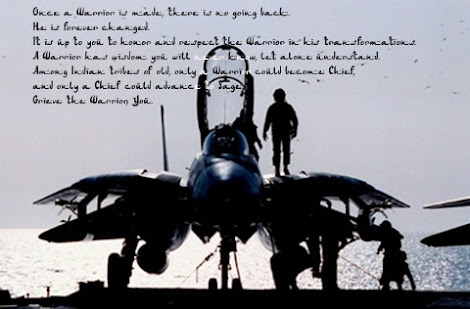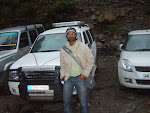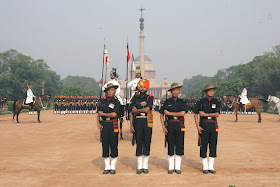After the end of WW II – India got independence from the British but the British divided up the country before moving out. The British wanted two things out of it:
1) They wanted a weak nation (Pakistan, that is), which would depend on Britain for its defense. 2) They wanted that newly-formed weak nation (aka PAKISTAN) to border the oil wells of Central Asia (part of the Soviet Union, then) and to be close to the Muslim-majority, oil-rich nations of the Middle East.
Corollary to the objective was that India, the larger of the two nations then in the subcontinent (now, with the emergence of Bangladesh in 1972, the subcontinent has three nations) must not have any common border with either Afghanistan (the buffer state) or the Soviet Union.Hence, Kashmir state must not go to India in its original form to INDIA and at best, status quo can be maintained.The British objective to control the oil wells was part of the Great Game to prevent the mighty Russian empire from having access to the oil fields. Former British Governor of the NorthWest Frontier Province during the British Raj days, Sir Olaf Caroe used to say the shadow of the north ( meaning: RUSSIA) must not extend over the wells of power. (The Objectives have not changed, hence we look at their genesis)Cut to the present: At the end of the first Gulf War in 1991, 55 percent of the 20 largest companies in the energy industry by market capitalization were American, and 45 percent were European, according to the Goldman Sachs Group Inc. study. But in 2007, 35 percent of the 20 largest energy companies are from BRIC (Brazil, Russia, India, China) countries, about 35 percent are European, and about 30 percent are American, the study said.According to predictions by a PricewaterhouseCoopers (PWC )’s head of macroeconomics, John Hawsworth report, the size of India's economy would swell to 90 per cent of that of the US by 2050, while China would be even larger than the US economy, having overtaken it as the largest economy in the world in around 2025. The above statements were made prior to the US economy tanking. With the current unprecedented economic crisis facing the US and Europe, the real gap of the economy between US vs China and India has shrunk. Though both Chinese and Indian economy have been hit by the global winds of recession, they have not been hurt to the extent the AAE has been hurt. Which means, the Chinese economy may already have inched closer to US economy and India may do so in the next 10 – 15 years.This is the bleak economic scenario facing the stalwarts of the Anglo American Empire (AAE) who need to protect their turf and business at “all costs”. Amongst the crème de la crème who mirror the interests of this AAE – Bilderberg group takes the cake. It is not an uber secret group like the Illuminati (the respected newsmagazine The Economist says Illuminati exists till date) but it is clearly very powerful.The security scenario facing the AAE presents it with an unique opportunity. The British, being past masters at espionage and diplomacy, managed to cull out the next big thing for the 21st century by 19th century and given a scientific basis in 1942 via Viceroy’s Study Group - control of oil wells at Central Asia. The US took over from Britain as the military, technical and financial wealth of US soared far above UK post WW II. UK’s second vision was to ensure that India did not get a common border with Afghanistan, hence arming and abetteting terror groups like Lashkar e Taiba (LeT) were encouraged by AAE, to create mayhem in Kashmir and keep India tied up. The American vision was also to keep the Chinese and Russians away and they played one against the other.Unfortunately for AAE, the security scenario did not exactly work out the way it wanted to be. It wanted Map 1, the failure of it resulted in revisiting and reinventing Map 2, but what confronts it today is Map 3.
meaning: RUSSIA) must not extend over the wells of power. (The Objectives have not changed, hence we look at their genesis)Cut to the present: At the end of the first Gulf War in 1991, 55 percent of the 20 largest companies in the energy industry by market capitalization were American, and 45 percent were European, according to the Goldman Sachs Group Inc. study. But in 2007, 35 percent of the 20 largest energy companies are from BRIC (Brazil, Russia, India, China) countries, about 35 percent are European, and about 30 percent are American, the study said.According to predictions by a PricewaterhouseCoopers (PWC )’s head of macroeconomics, John Hawsworth report, the size of India's economy would swell to 90 per cent of that of the US by 2050, while China would be even larger than the US economy, having overtaken it as the largest economy in the world in around 2025. The above statements were made prior to the US economy tanking. With the current unprecedented economic crisis facing the US and Europe, the real gap of the economy between US vs China and India has shrunk. Though both Chinese and Indian economy have been hit by the global winds of recession, they have not been hurt to the extent the AAE has been hurt. Which means, the Chinese economy may already have inched closer to US economy and India may do so in the next 10 – 15 years.This is the bleak economic scenario facing the stalwarts of the Anglo American Empire (AAE) who need to protect their turf and business at “all costs”. Amongst the crème de la crème who mirror the interests of this AAE – Bilderberg group takes the cake. It is not an uber secret group like the Illuminati (the respected newsmagazine The Economist says Illuminati exists till date) but it is clearly very powerful.The security scenario facing the AAE presents it with an unique opportunity. The British, being past masters at espionage and diplomacy, managed to cull out the next big thing for the 21st century by 19th century and given a scientific basis in 1942 via Viceroy’s Study Group - control of oil wells at Central Asia. The US took over from Britain as the military, technical and financial wealth of US soared far above UK post WW II. UK’s second vision was to ensure that India did not get a common border with Afghanistan, hence arming and abetteting terror groups like Lashkar e Taiba (LeT) were encouraged by AAE, to create mayhem in Kashmir and keep India tied up. The American vision was also to keep the Chinese and Russians away and they played one against the other.Unfortunately for AAE, the security scenario did not exactly work out the way it wanted to be. It wanted Map 1, the failure of it resulted in revisiting and reinventing Map 2, but what confronts it today is Map 3.
 meaning: RUSSIA) must not extend over the wells of power. (The Objectives have not changed, hence we look at their genesis)Cut to the present: At the end of the first Gulf War in 1991, 55 percent of the 20 largest companies in the energy industry by market capitalization were American, and 45 percent were European, according to the Goldman Sachs Group Inc. study. But in 2007, 35 percent of the 20 largest energy companies are from BRIC (Brazil, Russia, India, China) countries, about 35 percent are European, and about 30 percent are American, the study said.According to predictions by a PricewaterhouseCoopers (PWC )’s head of macroeconomics, John Hawsworth report, the size of India's economy would swell to 90 per cent of that of the US by 2050, while China would be even larger than the US economy, having overtaken it as the largest economy in the world in around 2025. The above statements were made prior to the US economy tanking. With the current unprecedented economic crisis facing the US and Europe, the real gap of the economy between US vs China and India has shrunk. Though both Chinese and Indian economy have been hit by the global winds of recession, they have not been hurt to the extent the AAE has been hurt. Which means, the Chinese economy may already have inched closer to US economy and India may do so in the next 10 – 15 years.This is the bleak economic scenario facing the stalwarts of the Anglo American Empire (AAE) who need to protect their turf and business at “all costs”. Amongst the crème de la crème who mirror the interests of this AAE – Bilderberg group takes the cake. It is not an uber secret group like the Illuminati (the respected newsmagazine The Economist says Illuminati exists till date) but it is clearly very powerful.The security scenario facing the AAE presents it with an unique opportunity. The British, being past masters at espionage and diplomacy, managed to cull out the next big thing for the 21st century by 19th century and given a scientific basis in 1942 via Viceroy’s Study Group - control of oil wells at Central Asia. The US took over from Britain as the military, technical and financial wealth of US soared far above UK post WW II. UK’s second vision was to ensure that India did not get a common border with Afghanistan, hence arming and abetteting terror groups like Lashkar e Taiba (LeT) were encouraged by AAE, to create mayhem in Kashmir and keep India tied up. The American vision was also to keep the Chinese and Russians away and they played one against the other.Unfortunately for AAE, the security scenario did not exactly work out the way it wanted to be. It wanted Map 1, the failure of it resulted in revisiting and reinventing Map 2, but what confronts it today is Map 3.
meaning: RUSSIA) must not extend over the wells of power. (The Objectives have not changed, hence we look at their genesis)Cut to the present: At the end of the first Gulf War in 1991, 55 percent of the 20 largest companies in the energy industry by market capitalization were American, and 45 percent were European, according to the Goldman Sachs Group Inc. study. But in 2007, 35 percent of the 20 largest energy companies are from BRIC (Brazil, Russia, India, China) countries, about 35 percent are European, and about 30 percent are American, the study said.According to predictions by a PricewaterhouseCoopers (PWC )’s head of macroeconomics, John Hawsworth report, the size of India's economy would swell to 90 per cent of that of the US by 2050, while China would be even larger than the US economy, having overtaken it as the largest economy in the world in around 2025. The above statements were made prior to the US economy tanking. With the current unprecedented economic crisis facing the US and Europe, the real gap of the economy between US vs China and India has shrunk. Though both Chinese and Indian economy have been hit by the global winds of recession, they have not been hurt to the extent the AAE has been hurt. Which means, the Chinese economy may already have inched closer to US economy and India may do so in the next 10 – 15 years.This is the bleak economic scenario facing the stalwarts of the Anglo American Empire (AAE) who need to protect their turf and business at “all costs”. Amongst the crème de la crème who mirror the interests of this AAE – Bilderberg group takes the cake. It is not an uber secret group like the Illuminati (the respected newsmagazine The Economist says Illuminati exists till date) but it is clearly very powerful.The security scenario facing the AAE presents it with an unique opportunity. The British, being past masters at espionage and diplomacy, managed to cull out the next big thing for the 21st century by 19th century and given a scientific basis in 1942 via Viceroy’s Study Group - control of oil wells at Central Asia. The US took over from Britain as the military, technical and financial wealth of US soared far above UK post WW II. UK’s second vision was to ensure that India did not get a common border with Afghanistan, hence arming and abetteting terror groups like Lashkar e Taiba (LeT) were encouraged by AAE, to create mayhem in Kashmir and keep India tied up. The American vision was also to keep the Chinese and Russians away and they played one against the other.Unfortunately for AAE, the security scenario did not exactly work out the way it wanted to be. It wanted Map 1, the failure of it resulted in revisiting and reinventing Map 2, but what confronts it today is Map 3.Genesis of Map 1: Revisiting the UK plan to create Pakistan – so that this new “small” largely Muslim country will be subservient to UK for defense and in return Pakistan will given UK a staging ground to be close to the oil wells of Central Asia (part of the Soviet Union, then) and to be close to the Muslim-majority, oil-rich nations of the Middle East. Pakistan proved to be an able ally of AAE in ousting Soviet Union from Afghanistan. The US helped ISI prop up Taliban in Afghanistan. The then US Assistant Secy of State for South Asian Affairs, ROBIN RAPHAEL went on to state – “The Taliban capture of Kabul is a POSITIVE STEP.”On December 4th 1997, the representatives of Taliban were invited guests at the Texas headquarters of UNOCAL to negotiate support for the pipeline.However in the 1990s, the overall US vision differed from UK vision for the region. US thought Iraq would be the best place to set up a base and run both the Central Asian gas as well as Middle East oil from there. The US abandoned Afghanistan after the Soviets left, but the British did not. CIA / MI6 / SAS covert team worked in tandem with ISI to send “terrorist” from Jaish e Mohammad, Lashkar e Taiba, Moro Liberation Front to Chenchneya, Dagestan, Kosovo, Bosnia. KSA intelligence infiltrated LeT and lent an opening to CIA to run “assets” for its operations. For all this, the AAE gave ISI a free hand to have “fun” in Kashmir. Given, that their partnership with Pakistan was bearing fruit, notwithstanding irritants, the AAE dreamt of controlling the oil wells of Central Asia and Middle East through a unified country to be called the United States of Islam, largely militarily run by Pakistan. Pakistan was encouraged to send in Taliban to take control of Afghanistan as long as the AAE got to construct UNOCAL pipelines to transport Central Asian gas through Afghanistan to warm water ports of Karachi. ISI liked Map 1 too – it was closer to its dream of establishing an Islamic Caliphate.
However, minor irritants were creeping in. Paksitan and ISI started acting on their own, away from the wishes of its masters in the AAE. In Bosnia, CIA used ISI help in sending “jedhais” to fight the Russian backed Serbs. However, without informing the US, Pakistan used military planes to airlift sophisticated anti-tank guided missiles and this forced the Serbs to life the siege, much to the annoyance of the US government. So incensed was the then US President Bill Clinton that he threatened to Pakistan Prime Minister Nawaz Sharif that Pakistan will be declared a TERRORIST STATE if Sharif did not remove Javed Nisar from top post of ISI. Which Sharif did and averted his nation from being called a Terrorist State.
Many such incidents, including AQ Khan's nuclear Walmart, made the AAE and its military backers realize that Pakistan was running a different agenda and hoodwinking the interests of AAE. This gave rise to Map 2 which divided up Pakistan along ethnic lines. Baluchistan was an independent country in the 19th century. Pakistan which saw dreams of running Islamic Caliphate envisioned in Map1 suddenly saw its fate as a weak fledgling nation captured in neo-con Map 2. The AAE were not at all happy with Pakistan and they were not going to give up business interests in Central Asian region and see the return of the Russian bear once again. To top it, newer gas fields were being discovered and with the discovery of Yolotan Osman gas reserves in Turkmenistan that was outside the business agreement that Turkmenistan had with Russia, gave AAE immense leverage and rationale to stay put in Afghanistan. Pakistan became important only as a transit route to feed NATO / US forces in Afghanistan. With US now implementing a new route bypassing Pakistan, the importance of Pakistan will come down tremendously. Pakistan, looking at this, has looked at China to couter the US moves. Pakistan has responded by doing three things:
1. Used its contacts in Afghan Taliban cells of Haqqani, Hekmatyar and Omar to launch assaults in Afghanistan on NATO – to ensure speedy “departure” of these forces.
2. Tried disrupting NATO supplies from its soil from time to time – which will logistically hurt the forces in absence of an alternative supply line currently
3. Opened up Gwadar port in Pakistan in collaboration with China – thus giving Chinese Navy a future berthing facility in Indian Ocean - a scenario not at all welcomed by US & India.
The US wanted to operationalize plans to activate plans to make the Map 2 a reality – however a Map 3 has been thrust in its face. Large tracts of land in between Pakistan and Afghanistan has been captured by Taliban. This poses a serious threat to the plans to AAE. Pakistan is aware of Map 2 and neo-con plans of US. It has countered by embedding its soldiers with Taliban and other terror groups. This has made Pakistan's western borders impregnable - the hostile terrain adding to the difficulty. Without Pakistan's help, one cannot mount ground operations in this area and win. With Map 3, Pakistan hopes to increase its bargaining powers with the AAE.The blast of Indian Embassy in Afghanistan was a plan originating from Level 2 – ie ISI and done by Level 1 actors aligned with the Haqqani groups. This was done to damage the India – AAE nexus from growing as Pakistan saw its “importance” being eroded away. India + AAE nexus seriously threatens Pakistan.Pakistan had to be stopped before it hurt the AAE any more and for that India was chosen to counter balance. India has come a long way from being a Soviet proxy to being embedded with the interests of the AAE – at least that is what Americans would like to believe.






















0 comments:
Post a Comment